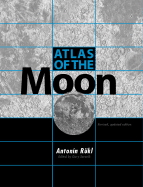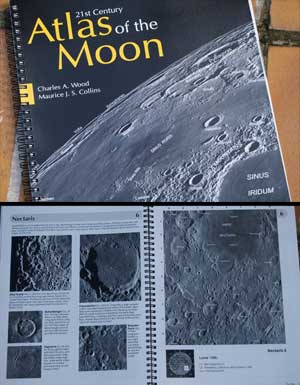

#MOON ATLAS BOOK WOOD PROFESSIONAL#
Amateur and professional astronomers now take advantage of this technology by creating systems that allow them to operate their observatories remotely from anywhere in the world. The twenty-first century has brought a revolution in communications via the Internet and wireless broadband technology. A basic introduction to image feature analysis is also presented to familiarize the amateur with the terminology and the concepts used in analyzing charge-coupled device (CCD) data. Planetary and lunar topography for amateurs is a recent field of study, and great strides have been made in the tools available for measuring these features. These three topics are the basis of all astronomical science and are discussed in a practical manner in this chapter.

Spectroscopy came later when chemical elements were discovered, and the connection between the Earth and the stars became evident through use of the first spectroscope invented by Fraunhofer, which showed the similarities between the patterns of spreading light from stars and from earthly sources. Photometry came soon after, when Hipparchos created the first photometric measurement system based on visual estimates of brightness. Astrometry was first, and the positions of the stars and planets were first to catch the earliest observers’ attention. The three pillars of astronomical measurement-astrometry, photometry, and spectroscopy-form the foundation for all the science done by amateur and professional astronomers from the earliest times until today. A case is made that instructional game design with embedded assessment is an enterprise requiring complex expertise among teams of professionals-topped by talent and creativity. Then CyGaMEs’ Selene: A Lunar Construction GaME design artifacts, screen captures, gameplay data, and analyses illustrate this approach to design and embedded assessment. Chapter discussion introduces the national initiative for cyberlearning and embedded assessment and insights from evidence-centered design and cognitive tutor development practices, especially regarding task analysis and cognitive task analysis. The approach is one way to address design for alignment and shortcomings and limitations documented in the literature that plague current learning game design, embedded assessment, and research. The CyGaMEs approach designs gameplay parameters as the Timed Report measure of player performance to quantify and trace trajectories of learning and achievement. After knowledge specification through a task analysis, the method applies cognitive science analogical reasoning theory to translate targeted learning goals into game goals and translate targeted knowledge as the game world (e.g., rules and core mechanics).

CyGaMEs produces games designed to provide viable prior knowledge as preparation for future learning. As such, CyGaMEs learning environments are transactional digital knowledge maps that make abstract concepts concrete and actionable: translating what experts know into procedures learners do (discover and apply). The CyGaMEs (Cyberlearning through Game-based, Metaphor Enhanced Learning Objects) approach to instructional game design and embedded assessment provides a formalism to translate domain knowledge into procedural gameplay. With this atlas we share this perspective with everyone.
#MOON ATLAS BOOK WOOD TV#
Now, using the first high-definition TV camera flown on a lunar spacecraft, images from the Japanese Kaguya lunar orbiter provided a perspective identical to what the astronauts experienced, but covering far more area than the Apollo astronauts saw.

Such vertical images provide a very utilitarian map view, but lack the sense of three-dimensionality of the astronaut’s perspective. These differed from most other orbital images of the Moon that were taken by robotic spacecraft, looking straight down. The interest increases as you get closer to the Moon, and in the 1960s and early 1970s Apollo astronauts in low lunar orbit captured many evocative photographs. But the Moon is more visibly interesting to a person on Earth with eyes, binoculars, or telescope than any other object in the universe. It is, of course, much smaller and less impressive in absolute dimensions than planets such as Mars and Jupiter and is hardly worthy of mentioning in the same sentence as a galaxy. The Moon is the most remarkable object in the nighttime sky.


 0 kommentar(er)
0 kommentar(er)
